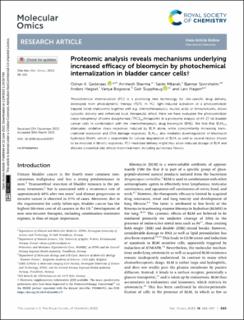Proteomic analysis reveals mechanisms underlying increased efficacy of bleomycin by photochemical internalization in bladder cancer cells
Gederaas, Odrun Arna; Sharma, Animesh; Mbarak, Saide; Sporsheim, Bjørnar; Høgset, Anders; Bogoeva, Vanya; Slupphaug, Geir; Hagen, Lars
Peer reviewed, Journal article
Published version
Permanent lenke
https://hdl.handle.net/11250/3101696Utgivelsesdato
2023Metadata
Vis full innførselSamlinger
Originalversjon
Gederaas, O. A., Sharma, A., Mbarak, S., Sporsheim, B., Høgset, A., Bogoeva, V., Slupphaug, G. & Hagen, L. (2023). Proteomic analysis reveals mechanisms underlying increased efficacy of bleomycin by photochemical internalization in bladder cancer cells. Molecular Omics, 19, 585-597. https://doi.org/10.1039/D2MO00337FSammendrag
Photochemical internalization (PCI) is a promising new technology for site-specific drug delivery, developed from photodynamic therapy (PDT). In PCI, light-induced activation of a photosensitizer trapped inside endosomes together with e.g. chemotherapeutics, nucleic acids or immunotoxins, allows cytosolic delivery and enhanced local therapeutic effect. Here we have evaluated the photosensitizer meso-tetraphenyl chlorine disulphonate (TPCS2a/fimaporfin) in a proteome analysis of AY-27 rat bladder cancer cells in combination with the chemotherapeutic drug bleomycin (BML). We find that BLMPCI attenuates oxidative stress responses induced by BLM alone, while concomitantly increasing transcriptional repression and DNA damage responses. BLMPCI also mediates downregulation of bleomycin hydrolase (Blmh), which is responsible for cellular degradation of BLM, as well as several factors known to be involved in fibrotic responses. PCI-mediated delivery might thus allow reduced dosage of BLM and alleviate unwanted side effects from treatment, including pulmonary fibrosis.

